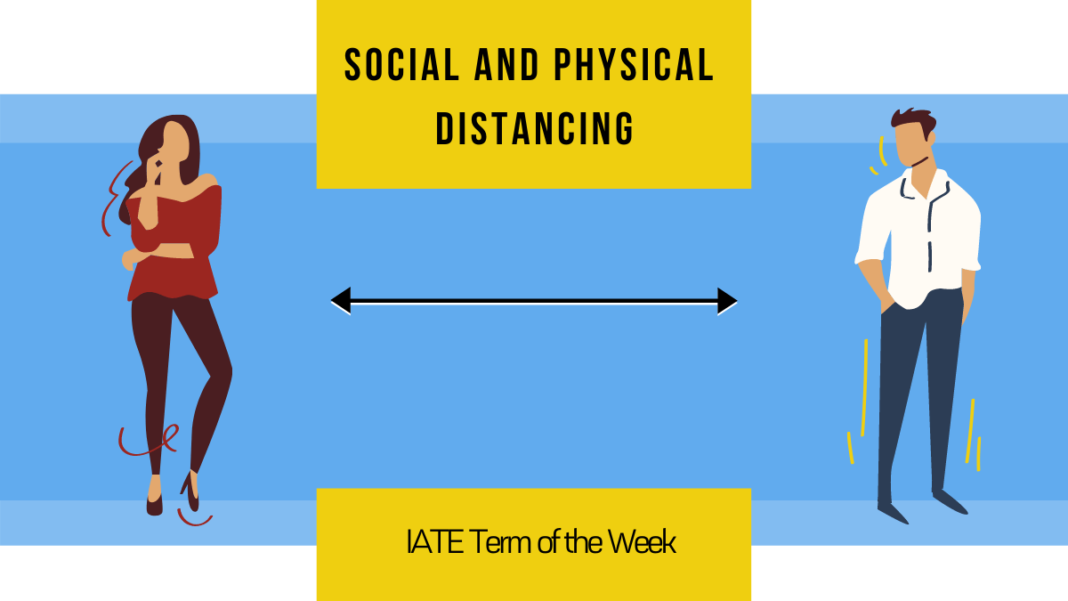What is ‘Social Distancing’?
The term ‘social distancing’ has entered our collective COVID-19 vocabulary. The European Centre for Disease Prevention and Control defines social distancing as “an action taken to minimise contact with other individuals”, while the Johns Hopkins Medical Institute describes it specifically as “staying at least six feet away [about two meters] from other people”. According to the WHO, COVID-19 spreads via liquid particles from an infected person’s mouth or nose when they speak, cough, or sneeze. The goal of social distancing is thus to increase the physical distance between people, so that these liquid particles do not reach another person’s eyes, nose or mouth. Some measures of social distancing include avoiding physical contact, such as hugs and handshakes, cancelling social gatherings, closing schools, enabling employees to work from home, and restricting travel.
The concept of diminishing physical contact to reduce the spread of an infectious disease has existed for a long time. For example, during the 1918 Spanish flu pandemic the authorities of the city of St. Louis in Missouri closed schools and banned social gatherings. The result: the death rate in St. Louis was lower than in other places of the United States.
Although the concept clearly has been around for at least a century, the Merriam-Webster dictionary traces the first recorded usage of the term ‘social distancing’ back to the year 2003. However, ’social distancing’ as a term was not frequently used before the COVID-19 pandemic. The graph below shows that interest in the term rose exponentially in March 2020, evidenced by a 100-fold increase in Google searches for ‘coronavirus social distancing’ and ‘social distancing definition’.

Social Distancing or Physical Distancing?
While the term ‘social distancing’ was at its peak, the WHO proposed in a press briefing in March 2020 that the term ‘physical distancing’ would be a more suitable alternative to the term ‘social distancing’. In the briefing, Dr Maria Van Kerkhove said:
“If I can just add, you may have heard us use the phrase physical distancing instead of social distancing […] keeping the physical distance from people so that we can prevent the virus from transferring to one another; that’s absolutely essential. But it doesn’t mean that socially we have to disconnect from our loved ones, from our family.”
What Dr Van Kerkhove points out is that the term ‘social distancing’ can be understood as encouraging people to disengage from their social network and to cut all contact with their friends and family. This is actually not the case: while individuals are indeed advised to avoid physical contact, they can and should remain socially connected with one another through technology and social media. As living through a pandemic and physical isolation can take a significant toll on mental health, it is important to keep in touch with loved ones as much as possible. Hence why Dr. Van Kerkhove suggests the term ‘physical distancing’ as an alternative.
Here at TermCoord, we were curious to see which term you thought was more suitable. We launched a Facebook poll and the results were loud and clear: the vast majority thought that ‘physical distancing’ was the more suitable term. So, practice physical distancing, make use of technology to remain socially connected to your loved ones, and above all, stay safe!
Sources
“Social Distancing”. IATE. [Accessed 31/03/2020].
“Social Distancing”. Merriam-Webster. [Accessed 31/03/2020].
Considerations relating to social distancing measures in response to COVID-19 – second update. European Centre for Disease Prevention and Control. [Accessed 31/03/2020].
Coronavirus, Social and Physical Distancing and Self-Quarantine. Johns Hopkins Medical Institute. [Accessed 31/03/2020].
Social Distancing is the Order of the Day. Statista. [Accessed 31/03/2020].
Ryan, J. R. (2008-08-01). “Chapter 6.3.3. Response and Containment: Lessons from the 1918 Pandemic Can Help Communities Today”. Pandemic Influenza: Emergency Planning and Community Preparedness. CRC Press. pp. 123–133 [133]. Archived from the original on 2020-03-29. Retrieved 29/03/2020. [Accessed 31/03/2020].
Harris, M., Adhanom Ghebreyesus, T., Liu, T., Ryan, M. J., Van Kerkhove, M. D., Foulkes, I., Ondelam, C., Gretler, C. “COVID-19” (PDF). World Health Organization. Archived (PDF) from the original on 25/03/2020. [Accessed 31/03/2020].

By Janna Mack. Born and raised in multilingual and multicultural Luxembourg, Janna speaks Luxembourgish, German, French, and English. She has degrees in Linguistics, Education, and Translation from the University of Glasgow, Scotland.


